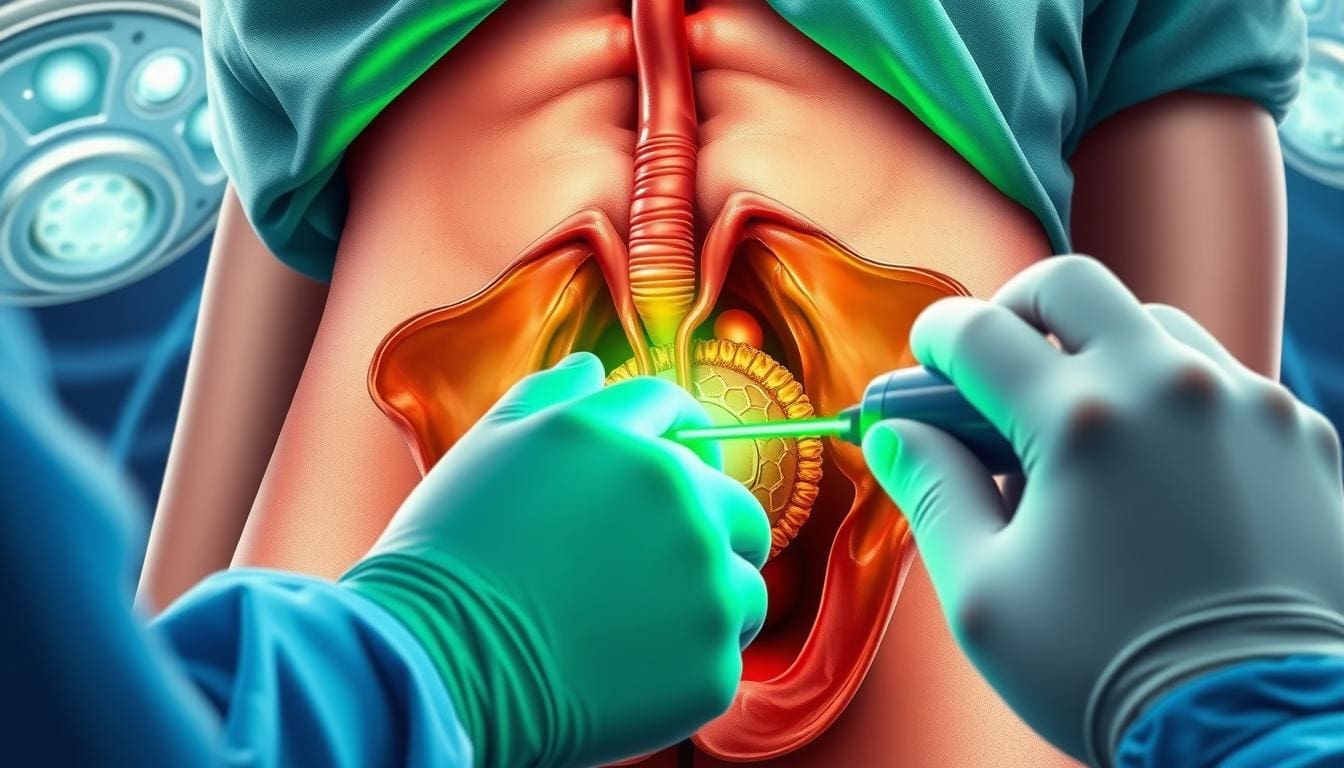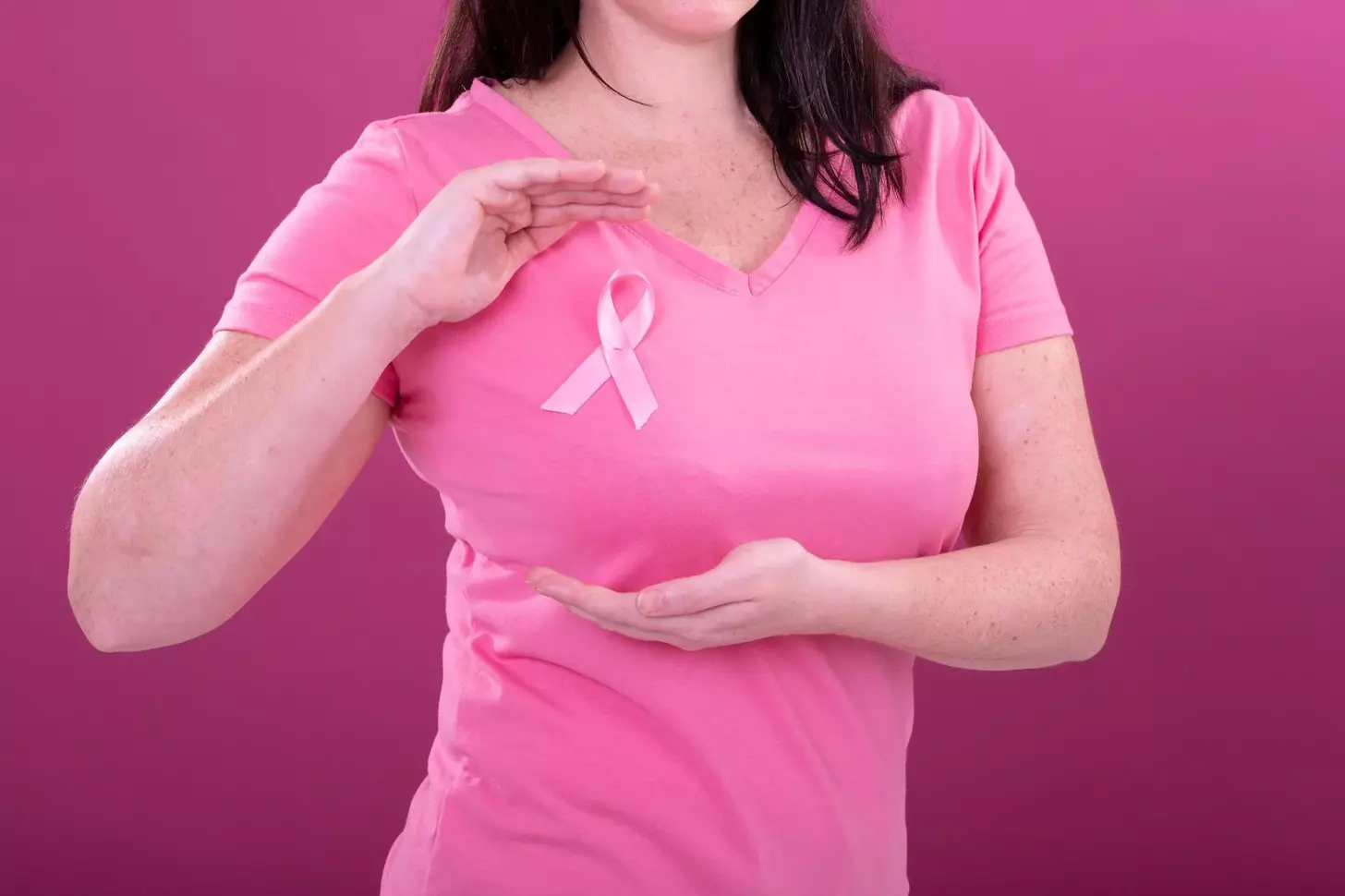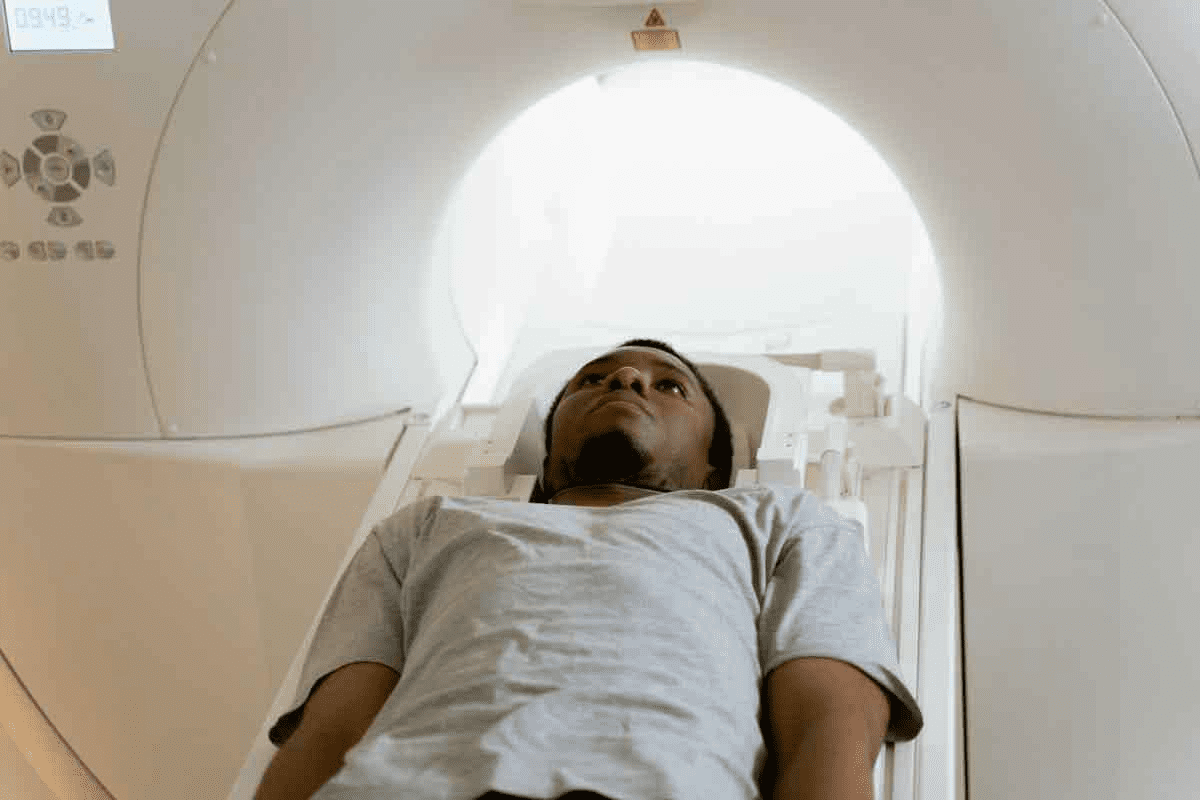Last Updated on November 26, 2025 by Bilal Hasdemir
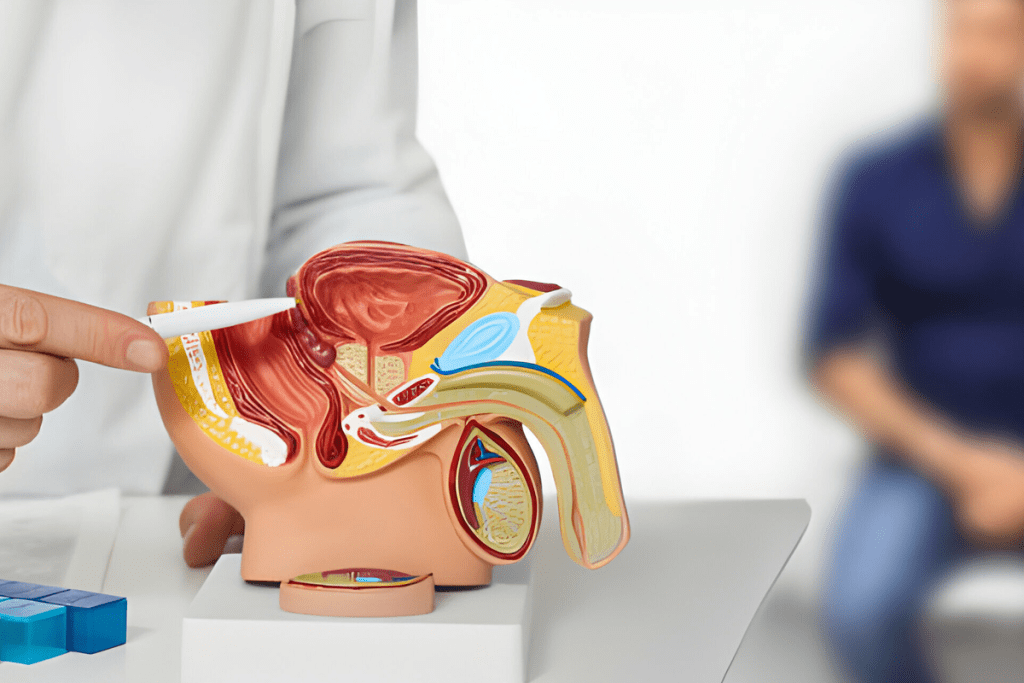
Did you know nearly half of men over 50 have benign prostatic hyperplasia (BPH), or an enlarged prostate symtoms? This can really affect a man’s life, causing pain and changing his daily habits.
As men get older, their prostate gland can grow. This can press on the urethra and mess with how they pee. Knowing the signs of an enlarged prostate is key to getting help and keeping your prostate health in check.
In this article, we’ll look at the 5 main signs of an enlarged prostate. This will help you spot problems early and talk to a doctor.
Key Takeaways
- Understanding the risks associated with benign prostatic hyperplasia.
- Recognizing the common symptoms of an enlarged prostate.
- The importance of timely medical consultation for prostate health.
- Lifestyle changes that can help manage symptoms of enlarged prostate.
- Treatment options available for managing BPH.
Understanding the Prostate Gland
Knowing about the prostate gland is key for men’s health. It affects both urine flow and sexual health. The prostate is a vital part of the male body, impacting a man’s life quality.
What is the Prostate?
The prostate, or prostate gland, is a small gland in the male pelvis. It’s like a walnut and is part of the male reproductive system. It helps make seminal fluid, which supports and protects sperm.
The prostate gland has glandular and muscular tissues. The glandular tissue makes prostatic fluid, a big part of semen. The muscular tissue helps push out this fluid during ejaculation.
Normal Prostate Function
The prostate’s main job is to make prostatic fluid. This fluid is full of enzymes, hormones, and other stuff that help sperm work well.
“The prostate gland’s role in producing seminal fluid is critical for male fertility.”
The prostate also helps control urine flow. It’s around the urethra, the tube urine goes through. A healthy prostate ensures urine flows right.
Prostate Location and Anatomy
The prostate is below the bladder and in front of the rectum. It’s around the urethra, which carries urine out.
The prostate’s anatomy is complex, with different areas that can get sick. Knowing its layout is key for diagnosing and treating prostate problems.
| Prostate Zone | Description | Common Conditions |
| Peripheral Zone | Outer part of the prostate | Prostate cancer |
| Transition Zone | Inner part surrounding the urethra | Benign Prostatic Hyperplasia (BPH) |
| Central Zone | Area surrounding the ejaculatory ducts | Less commonly affected by disease |
What is Benign Prostatic Hyperplasia (BPH)?
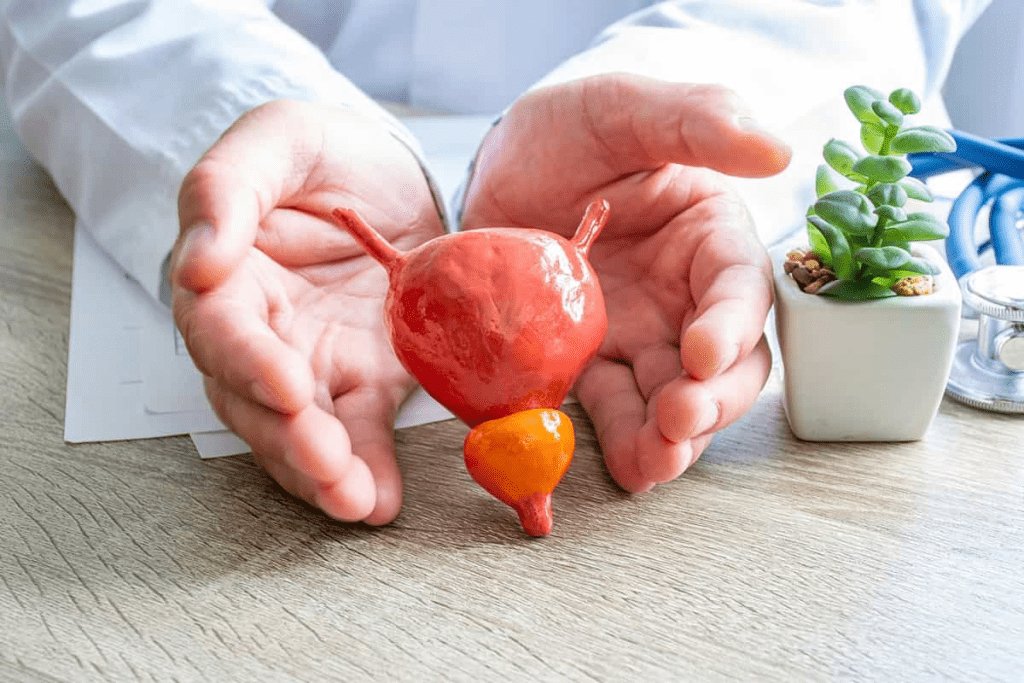
Benign Prostatic Hyperplasia (BPH) is a non-cancerous growth of the prostate gland. It’s a common issue for men, getting more common with age. We’ll look into what an enlarged prostate is, how it differs from prostate cancer, and its commonality among men.
Definition of Enlarged Prostate
An enlarged prostate, or BPH, happens when the prostate gland gets bigger. This can squeeze the urethra and affect urine flow. It’s not cancer but can greatly impact a man’s life quality.
The prostate gland is around the urethra. When it grows, it can block the urethra. This leads to various urinary symptoms.
Difference Between BPH and Prostate Cancer
It’s important to know the difference between BPH and prostate cancer. Both affect the prostate gland but are different. BPH is non-cancerous, while prostate cancer is cancerous and can spread.
Understanding this difference is key for the right diagnosis and treatment.
Prevalence of BPH in Men
BPH is very common in older men. Studies show over half of men in their 60s and up to 90% in their 70s and 80s have BPH. The more a man ages, the more likely he is to have BPH.
BPH is a widespread condition among men. Knowing what it is, how it differs from prostate cancer, and its commonality is vital for managing and treating it.
Enlarged Prostate Symptoms: The 5 Warning Signs
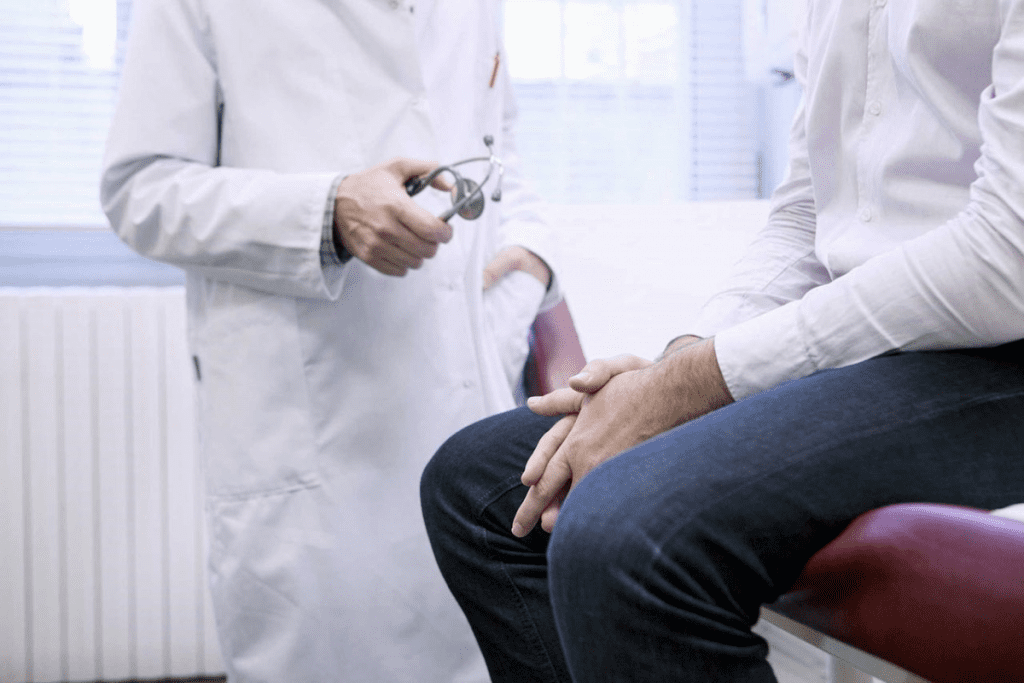
It’s important for men to know the signs of an enlarged prostate. As men get older, their prostate gland can grow, causing benign prostatic hyperplasia (BPH). This growth can lead to urinary symptoms that affect daily life.
Overview of Symptom Development
Symptoms of an enlarged prostate start slowly. At first, men might notice small changes in their urine habits. If not treated, these symptoms can get worse.
Key factors influencing symptom development include:
- The degree of prostate enlargement
- The presence of other urinary conditions
- Overall health and lifestyle factors
How Symptoms Progress Over Time
As BPH gets worse, symptoms can get more severe. Men might need to urinate more often, feel a strong urge to go, and have trouble starting or stopping the flow. Knowing how symptoms get worse is key to managing the condition.
The progression of symptoms can be influenced by various factors, including age, genetics, and lifestyle choices.
| Symptom | Early Stage | Advanced Stage |
| Urinary Frequency | Occasional | Frequent |
| Urine Stream | Weak | Very Weak or Interrupted |
Impact on Quality of Life
Symptoms of an enlarged prostate can really affect a man’s life. Nocturia, or needing to pee at night, can mess up sleep, making you tired and less productive. Also, the stress and shame of these symptoms can hurt your social and work life.
To mitigate the impact on quality of life, men can:
- Seek medical attention early
- Adopt lifestyle changes to manage symptoms
- Explore treatment options with their healthcare provider
Warning Sign #1: Urinary Frequency
Urinary frequency is an early sign of an enlarged prostate. It makes daily life harder. You might need to go to the bathroom more often than usual.
Why BPH Causes Frequent Urination
BPH makes the prostate gland grow. This can press against the urethra. It affects urine flow and makes you feel like you’re not emptying your bladder fully.
Daytime vs. Nighttime Frequency (Nocturia)
Urinary frequency can happen during the day or at night. Nocturia, or nighttime frequency, is really hard because it messes with your sleep. Knowing the difference helps in figuring out and treating BPH symptoms.
| Characteristics | Daytime Frequency | Nighttime Frequency (Nocturia) |
| Timing | Occurs during waking hours | Occurs during sleep hours |
| Impact | Disrupts daily activities | Disrupts sleep patterns |
| Common Causes | Fluid intake, BPH, other medical conditions | BPH, fluid intake before bedtime, sleep disorders |
When to Be Concerned About This Symptom
Some urinary frequency is normal, but a big increase is a worry. If you have pain, trouble starting to urinate, or other symptoms, see a doctor. They can check and help manage your symptoms.
Warning Sign #2: Weak Urine Stream
Problems with urine flow, like a weak stream, are common signs of an enlarged prostate. This can make daily life hard, causing discomfort and trouble with simple tasks.
Mechanics of Urinary Flow Problems
The prostate gland is around the urethra, which carries urine out of the body. When the prostate gets bigger, it can squeeze the urethra. This blocks urine flow, causing a weak stream. It can also lead to other issues like a weaker or interrupted flow.
Gradual vs. Sudden Changes in Stream
Changes in urine stream can happen slowly or suddenly. Slow changes often show up in men with BPH, where the prostate grows over time. Sudden changes might mean something else, like an infection or a stone in the prostate.
Self-Assessment of Stream Strength
Men can check their urine stream strength themselves. They can watch how it flows and if it’s weak or stops and starts. Keeping a diary of their urine can also help track changes. This info is useful for doctors.
| Symptom | Description | Possible Cause |
| Weak Urine Stream | Reduced force or flow of urine | Prostate Enlargement (BPH) |
| Interrupted Flow | Urine flow stops and starts during urination | Urethral Obstruction |
| Straining to Urinate | Need to push or strain to start or maintain urine flow | Prostate Enlargement or Urethral Stricture |
Warning Sign #3: Difficulty Starting Urination
Urinary hesitancy, or difficulty starting urination, can really change a man’s life. It’s when it’s hard to start peeing, even when you really need to. This can be very frustrating.
Understanding Urinary Hesitancy
Urinary hesitancy often comes from Benign Prostatic Hyperplasia (BPH). This is when the prostate gets too big and blocks urine flow. This blockage can make it hard to start peeing.
Physical Mechanisms Behind This Symptom
The prostate getting too big is the main cause. It presses on the urethra, the tube urine flows through. This makes it tough to start peeing.
The bladder muscle might also get too strong. It tries to push past the blockage, but this can cause more problems.
Impact on Daily Activities
Having trouble starting to pee can really mess up your day. It can make you feel anxious and upset, making it hard to find restrooms. It might even stop you from going out or traveling.
Trying to pee can also make prostate problems worse. This can make BPH symptoms even more of a challenge, creating a cycle of discomfort.
Warning Sign #4: Urinary Urgency
Urinary urgency is a common symptom of an enlarged prostate. It makes you feel like you need to urinate right away. This can really mess up your day and make life less enjoyable.
The Sudden Need to Urinate
Men with BPH often feel a strong urge to urinate. This urge can happen anytime, day or night. It can be very uncomfortable.
This urge is often because of an enlarged prostate blocking the urethra. This blockage makes it hard for urine to flow normally. It leads to a feeling of needing to urinate quickly.
Relationship to Prostate Enlargement
Urinary urgency and prostate enlargement are linked. When the prostate gets bigger, it can block the bladder. This makes it hard for the bladder to empty fully. It also irritates the bladder, making you feel like you need to urinate more.
This isn’t just about the blockage. It’s also how the bladder reacts to it. The bladder muscle can get too active. This makes you feel like you need to urinate, even if your bladder isn’t full.
Managing Urgency in Daily Life
There are ways to manage urinary urgency. Changing your lifestyle and sometimes using medicine can help. Bladder training, for example, can help you control your bladder better.
Drinking less water before bed and avoiding things like caffeine and alcohol can also help. For some, medicines that relax the prostate and bladder may be needed.
By understanding why you feel this way and making these changes, you can manage urinary urgency. This can make your life better overall.
Warning Sign #5: Incomplete Bladder Emptying
Feeling like your bladder isn’t empty after you pee is a big worry. This is called incomplete bladder emptying. It’s a clear sign that something might be wrong with your prostate.
Feeling of Residual Urine
Many men with BPH feel like they have urine left in their bladder. This feeling of residual urine makes them need to pee again soon after. It’s not just how often you pee that matters, but how well you pee too.
Men with this issue often say they:
- Always feel like they need to pee
- Leak or dribble after they finish peeing
- Have a weak or broken urine stream
Complications of Incomplete Emptying
If you don’t get help for this, it can cause big problems. These BPH complications include:
- Urinary Tract Infections (UTIs): Bacteria can grow in the urine that stays in your bladder.
- Bladder Stones: The concentrated urine can cause stones to form.
- Bladder Damage: Your bladder muscle can get weak or damaged over time.
These issues show why you should see a doctor if your symptoms don’t go away.
Self-Assessment Techniques
Even though a doctor’s check-up is key, you can do simple checks at home. Try these:
- Keep track of how often and urgently you pee
- Notice how strong and steady your pee stream is
- Watch for any dribbling or leakage
Keeping a voiding diary can really help. It shows patterns and changes in your pee habits. This info is great to share with your doctor.
Distinguishing BPH from Other Urinary Conditions
It’s important to know the differences between Benign Prostatic Hyperplasia (BPH) and other urinary problems. BPH is common in older men but can be confused with other issues. This makes it key to get a correct diagnosis.
Prostatitis vs. BPH Symptoms
Prostatitis, or prostate inflammation, shares some symptoms with BPH like trouble urinating and needing to go often. But, prostatitis usually hurts in the prostate area, unlike BPH. Getting a proper diagnosis means a detailed check-up.
Urinary Tract Infections
Urinary tract infections (UTIs) can also show symptoms like BPH, like needing to pee a lot. UTIs are usually caused by bacteria and need antibiotics. They also often have symptoms like burning when you pee and urine that smells or looks cloudy.
Overactive Bladder Syndrome
Overactive bladder syndrome makes you suddenly need to pee, often a lot. These symptoms can be like BPH but aren’t caused by an enlarged prostate. Treatment can vary and might include lifestyle changes, medicines, or therapy.
Prostate Cancer Warning Signs
Prostate cancer can also have symptoms like BPH, like trouble starting to pee or a weak stream. But, early prostate cancer often doesn’t show symptoms. When symptoms do appear, they might include pain or trouble peeing, and in later stages, bone pain or other signs. Early detection is key for good treatment.
| Condition | Common Symptoms | Distinguishing Features |
| BPH | Urinary frequency, weak urine stream, difficulty starting urination | Typically gradual onset, mainly in older men |
| Prostatitis | Pain in prostate area, urinary frequency, difficulty urinating | Often has pain, can happen at any age |
| Urinary Tract Infections | Burning during urination, cloudy or strong-smelling urine, urinary frequency | Caused by bacterial infection, can happen at any age |
| Overactive Bladder Syndrome | Sudden urge to urinate, urinary frequency | Not directly related to prostate enlargement |
| Prostate Cancer | Difficulty starting urination, weak urine flow, pain or difficulty urinating | Often doesn’t show symptoms early, can cause systemic symptoms in later stages |
To tell BPH apart from other urinary issues, a full check-up is needed. This includes looking at your medical history, doing a physical exam, and running tests. Seeing a doctor is vital for the right diagnosis and treatment.
“The key to managing urinary symptoms effectively lies in accurate diagnosis. Understanding the differences between BPH and other urinary conditions can significantly impact treatment outcomes.”
What Causes an Enlarged Prostate?
An enlarged prostate comes from a mix of age, hormones, genes, and lifestyle. Knowing these causes helps men take care of their prostate health.
Age-Related Factors
Age is a big risk for an enlarged prostate. As men get older, the chance of having BPH grows. By 50, about 50% of men have BPH. By 80, it’s nearly 80%.
Hormonal Influences
Hormones, like testosterone turning into DHT, are key. DHT makes prostate cells grow, leading to BPH.
Genetic Predisposition
Genetics also play a part. Men with BPH in their family are more likely to get it. Genes can affect when and how bad BPH symptoms are.
Lifestyle Contributors
Lifestyle, like diet and exercise, can also affect BPH risk. Eating a lot of red meat and dairy, and not enough fruits and veggies, raises risk. But, staying active can help lower it.
To understand how these factors lead to BPH, let’s look at the data:
| Risk Factor | Description | Impact on BPH Risk |
| Age | Increased age | Higher risk with increasing age |
| Hormonal Changes | Conversion of testosterone to DHT | Promotes prostate cell growth |
| Genetic Predisposition | Family history of BPH | Increases likelihood and severity |
| Lifestyle Factors | Diet and physical activity | Diet high in red meat and low physical activity increases risk |
As the table shows, many factors lead to an enlarged prostate. Knowing these can help men and doctors find good ways to manage it.
Complications of Untreated Enlarged Prostate
An untreated enlarged prostate can cause serious health problems. Benign prostatic hyperplasia (BPH) affects many men, mainly as they get older. It’s not cancer, but it can really affect your life and lead to worse health issues if not treated.
Urinary Retention
Urinary retention is a common problem with untreated BPH. The enlarged prostate can block the urethra, making it hard to fully empty the bladder. This can happen suddenly or gradually over time.
Key symptoms of urinary retention include:
- Difficulty starting urination
- Weak or interrupted urine flow
- Straining to urinate
- Feeling like the bladder is not fully emptied
Urinary Tract Infections
Untreated BPH can also cause urinary tract infections (UTIs). If the bladder doesn’t empty fully, bacteria can grow. UTIs can be painful and, if not treated, can lead to kidney infections.
Common symptoms of UTIs include:
- Burning sensation while urinating
- Frequent urination
- Urgent need to urinate
- Cloudy or strong-smelling urine
Bladder Stones and Damage
Bladder stones and damage are also risks with untreated enlarged prostate. If the bladder doesn’t empty, minerals can form stones. These stones can cause pain, bleeding, and infections.
Bladder damage can result from:
- Prolonged obstruction of urine flow
- Recurrent infections
- Bladder stones
Kidney Problems
In severe cases, untreated BPH can harm the kidneys. The buildup of urine can put pressure on the kidneys, leading to damage or failure. This is a serious issue that shows why treating BPH symptoms is so important.
Dealing with an enlarged prostate is tough, but knowing the risks is key. Getting medical help early can prevent these serious problems and help you live better.
When to See a Doctor About Prostate Symptoms
Knowing when to see a doctor for prostate symptoms is key. Prostate problems can really affect a man’s life. Getting help early can stop bigger issues.
Red Flag Symptoms Requiring Immediate Attention
Some symptoms need you to see a doctor right away. These include:
- Severe urinary retention: not being able to pee
- Painful urination: feeling pain or burning when you pee
- Blood in urine or semen: seeing blood, which is a big warning sign
- Severe pain: pain in your lower back, pelvis, or upper thighs
If you have any of these, go see a doctor fast.
Tracking Your Symptoms
Writing down your symptoms can help a lot. Note how often, how bad, and what makes it better or worse. This info helps doctors figure out what’s wrong and how to fix it.
| Symptom | Frequency | Severity |
| Urinary Frequency | Every 2 hours | Moderate |
| Nocturia | 3 times/night | Severe |
| Weak Urine Stream | Constant | Mild |
Preparing for Your Doctor’s Appointment
Before you go, write down your symptoms and when they started. Also, list any medicines you’re taking. This helps your doctor help you better.
Being ready and informed helps you and your doctor manage your symptoms well.
Treatment Options for Benign Prostatic Hyperplasia
Benign Prostatic Hyperplasia (BPH) treatment has many options. These range from simple management to surgery. The right choice depends on symptom severity, health, and personal wishes.
Watchful Waiting Approach
Men with mild symptoms might start with watchful waiting. This means keeping an eye on symptoms and prostate size over time. Regular check-ups are key to track any changes.
Benefits: It avoids or delays medication or surgery, reducing side effects.
Considerations: It needs regular follow-ups to adjust the treatment plan as needed.
Medication Options
For more severe symptoms, medication is often prescribed. There are two main types: alpha-blockers and 5-alpha-reductase inhibitors.
- Alpha-blockers relax the prostate and bladder neck muscles, making urination easier.
- 5-alpha-reductase inhibitors shrink the prostate by blocking DHT hormone production.
Benefits: They can greatly improve urinary symptoms and quality of life.
Considerations: They might cause side effects like dizziness, low blood pressure, or sexual issues.
Minimally Invasive Procedures
For those not responding to medication or preferring not to take it long-term, there are minimally invasive options. These include:
- Transurethral microwave therapy (TUMT)
- Transurethral needle ablation (TUNA)
- Laser therapy
Benefits: They are less invasive than surgery, with quicker recovery times.
Considerations: They might not work for everyone, and long-term results can vary.
Surgical Interventions
When other treatments fail or symptoms are severe, surgery might be needed. The most common surgery is transurethral resection of the prostate (TURP).
Benefits: It can provide lasting relief from symptoms.
Considerations: Surgery carries risks like bleeding, infection, and impacts on sexual function or urinary continence.
Understanding these options and talking to a healthcare provider can help men with BPH make informed decisions.
Lifestyle Changes to Manage Enlarged Prostate Symptoms
Changing your lifestyle can greatly improve life for men with BPH. Making smart choices about diet, exercise, and fluid intake can help manage symptoms. This might even reduce the need for medical treatments.
Dietary Modifications
Diet is key in managing BPH symptoms. Some foods can make urinary issues worse, while others help. Eating lots of fruits, vegetables, and whole grains is good for your prostate. Avoid foods that irritate your bladder, like spicy foods, caffeine, and alcohol.
Research shows that eating too much processed food and red meat can worsen BPH. But, foods rich in omega-3 fatty acids, like fish and nuts, may help because of their anti-inflammatory effects.
| Food Group | Recommended Foods | Foods to Limit/Avoid |
| Fruits & Vegetables | Berries, citrus fruits, tomatoes, leafy greens | High-acid fruits like oranges and grapefruits in excess |
| Proteins | Fish (salmon, sardines), nuts, lean meats | Red meat, processed meats |
| Grains | Whole grains (brown rice, quinoa) | Refined grains |
Exercise Recommendations
Regular exercise is vital for managing BPH symptoms. It can improve your urinary function and overall health. Walking, cycling, and swimming are great because they’re easy on your body and fit all fitness levels.
Benefits of Exercise for BPH:
- Improves urinary flow
- Reduces symptoms of BPH
- Enhances overall physical and mental health
Fluid Management Strategies
It’s important to manage your fluid intake if you have BPH. Staying hydrated is good, but do it in a way that doesn’t make you urinate too often. Drinking less in the evening can help you sleep better.
“Monitoring and adjusting fluid intake based on activity and time of day can significantly impact BPH symptom management.” –
A urology specialist
Bladder Training Techniques
Bladder training helps you control your bladder and urinate less often. It’s great for managing BPH symptoms like urgency and frequency.
Steps for Bladder Training:
- Keep a bladder diary to track urination patterns
- Gradually increase the time between trips to the bathroom
- Practice relaxation techniques to help manage urgency
Conclusion
It’s important to know the warning signs of an enlarged prostate. This is key for keeping your prostate and overall health in check. Benign Prostatic Hyperplasia (BPH) is a common issue for many men, getting more common with age.
The five warning signs to watch for are especially important. They are: needing to pee a lot, having a weak stream, trouble starting to pee, feeling a strong need to pee, and not emptying your bladder fully. These signs might mean you have an enlarged prostate.
Spotting these symptoms early can help avoid bigger problems. Issues like not being able to pee, infections, and bladder damage can happen. By knowing these signs and getting medical help, men can manage their prostate health better.
Handling BPH well means making lifestyle changes, getting medical help, and sometimes surgery. A full approach to prostate health can improve your life quality. We urge men to watch their prostate health closely and see a doctor if they notice any BPH warning signs.
FAQ
What is an enlarged prostate?
An enlarged prostate, also known as Benign Prostatic Hyperplasia (BPH), is when the prostate gland gets bigger. This can cause urinary symptoms.
What are the common symptoms of an enlarged prostate?
Symptoms include needing to urinate often, a weak urine stream, and trouble starting to urinate. You might also feel a strong need to urinate and not empty your bladder fully.
Is an enlarged prostate the same as prostate cancer?
No, an enlarged prostate (BPH) is not cancerous. It’s different from prostate cancer, even though both can make urinating hard.
What causes an enlarged prostate?
The exact cause is not known. But age, hormones, genetics, and lifestyle might play a part.
How is an enlarged prostate diagnosed?
Doctors use a medical history, physical exam, and sometimes tests like PSA testing or urodynamic studies to diagnose it.
What are the treatment options for an enlarged prostate?
Treatments include watching it, taking medicine, or doing minimally invasive procedures. Surgery might be needed for severe cases.
Can lifestyle changes help manage enlarged prostate symptoms?
Yes, changing your diet, exercising, managing fluids, and training your bladder can help with symptoms.
What are the possible complications of untreated enlarged prostate?
Untreated BPH can cause urinary retention, infections, stones, and damage to the bladder and kidneys.
When should I see a doctor about prostate symptoms?
See a doctor if you have severe symptoms like not being able to urinate or if symptoms really bother you.
Can an enlarged prostate be cured?
There’s no cure, but treatments can manage symptoms and improve life quality.
How can I reduce the risk of developing an enlarged prostate?
A healthy lifestyle, including a good diet and exercise, might help. But age and genetics are beyond your control.
Reference
- Cornford, P., et al. (2024). EAU-EANM-ESTRO-ESUR-ISUP-SIOG Guidelines on Prostate Cancer. European Urology, 86(2), 183-204. https://pubmed.ncbi.nlm.nih.gov/38614820/


